
Turmeric is a flowering plant, Curcuma longa of the ginger family, Zingiberaceae, the roots of which are used in cooking. The plant is a perennial, rhizomatous, herbaceous plant native to the Indian subcontinent and Southeast Asia, that requires temperatures between 20 and 30 °C and a considerable amount of annual rainfall to thrive. Plants are gathered each year for their rhizomes, some for propagation in the following season and some for consumption.
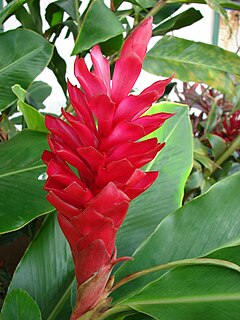
The Zingiberales are flowering plants forming one of four orders in the commelinids clade of monocots, together with its sister order, Commelinales. The order includes 68 genera and 2,600 species. Zingiberales are a unique though morphologically diverse order that has been widely recognised as such over a long period of time. They are usually large herbaceous plants with rhizomatous root systems and lacking an aerial stem except when flowering. Flowers are usually large and showy, and the stamens are often modified (staminodes) to also form colourful petal-like structures that attract pollinators.

Zingiberaceae or the ginger family is a family of flowering plants made up of about 50 genera with a total of about 1600 known species of aromatic perennial herbs with creeping horizontal or tuberous rhizomes distributed throughout tropical Africa, Asia, and the Americas. Members of the family Zingiberaceae including turmeric, ginger, Javanese ginger, and galangal have been used for centuries in traditional medicine. Preclinical studies of Zingiberaceae extracts have shown analgesic properties.
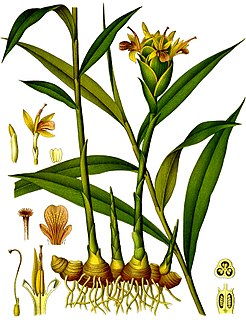
The genus Zingiber is native to Southeast Asia especially in Thailand, China, the Indian Subcontinent, and New Guinea. It contains the true gingers, plants grown the world over for their medicinal and culinary value. The most well known are Z. officinale and Z. mioga, two garden gingers.

Curcuma alismatifolia, Siam tulip or summer tulip is a tropical plant native to Laos, northern Thailand, and Cambodia. Despite its name, it is not related to the tulip, but to the various ginger species such as turmeric. It can grow as an indoor plant, and is also sold as a cut flower.

Curcuma is a genus of about 100 accepted species in the family Zingiberaceae that contains such species as turmeric and Siam tulip. They are native to Southeast Asia, southern China, the Indian Subcontinent, New Guinea and northern Australia. Some species are reportedly naturalized in other warm parts of the world such as tropical Africa, Central America, Florida, and various islands of the Pacific, Indian and Atlantic Oceans. Generally, most curcuma grows well in loose and sandy soil in shaded areas.

Hedychium is a genus of flowering plants in the ginger family Zingiberaceae, native to lightly wooded habitats in Asia. There are approximately 70-80 known species, native to India, Southeast Asia, and Madagascar. Some species have become widely naturalized in other lands, and considered invasive in some places.

Hedychium coronarium is a perennial flowering plant in the Zingiberaceae (ginger) family, native to the Eastern Himalayas region of India, Bangladesh, Nepal and Bhutan, through northernmost Myanmar and Thailand, southern China to Taiwan in the East. It is typically found growing in the forest understory, where the pseudostems arising from rhizomes below ground may reach 1-3m in height. In its native environment flowering occurs between August and December.

Curcuma amada, or mango ginger is a plant of the ginger family Zingiberaceae and is closely related to turmeric. The rhizomes are very similar to common ginger but lack its pungency, and instead have a raw mango flavour. They are used in making pickles in south India and chutneys in north India. The taxonomy of the species is a subject of some confusion as some authorities have considered the name C. mangga as identical while others describe it as a distinct species with C. mangga being found in southern India while C. amada is of east Indian origin. Mango-ginger is a popular spice and vegetable due to its rich flavor, which is described as sweet with subtle earthy floral and pepper overtones and similar to that of raw mango. It is a delicious addition to salads and stir fries. It is used in South Asian and Southeast Asian as well as Far East Asian cuisines.

Alcea rosea, the common hollyhock, is an ornamental dicot flowering plant in the family Malvaceae. It was imported into Europe from southwestern China during, or possibly before, the 15th century. William Turner, a herbalist of the time, gave it the name "holyoke" from which the English name derives.
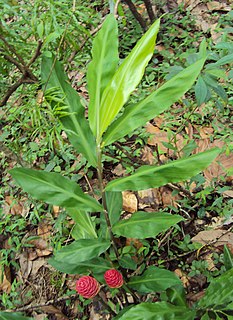
Zingiber zerumbet is a species of plant in the ginger family with leafy stems growing to about 1.2 m (3.9 ft) tall. It originates from Asia, but can be found in many tropical countries. Common names include: awapuhi, bitter ginger, shampoo ginger and pinecone ginger.
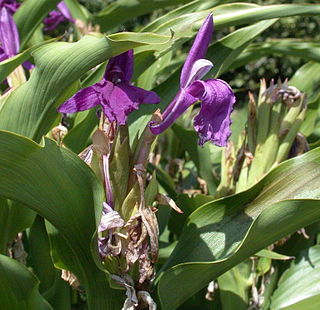
Roscoea is a genus of perennial plants of the family Zingiberaceae. Most members of the family are tropical, whereas Roscoea species are native to mountainous regions of the Himalayas, China and its southern neighbours. Roscoea flowers superficially resemble orchids, although they are not related. The flowers of Roscoea have a complicated structure, in which some of the showy coloured parts are not formed by petals, but by staminodes, sterile stamens which have evolved to become like petals. Some species are grown as ornamental plants in gardens.

Ribes speciosum is a species of flowering plant in the family Grossulariaceae, which includes the edible currants and gooseberries. It is a spiny deciduous shrub with spring-flowering, elongate red flowers that resemble fuchsias, though it is not closely related. Its common names are fuchsia-flowered gooseberry and Californian fuchsia. It is native to central and southern California and Baja California, where it grows in the scrub and chaparral of the coastal mountain ranges.

Cautleya is a small genus of perennial plants of the family Zingiberaceae, found in the eastern Himalayas through to China and Vietnam. It consists of two species of high-altitude tropical and temperate exotic jungle gingers, native to cool forest areas – an unusual habitat for members of the Zingiberaceae. They are grown as ornamental flowering plants.
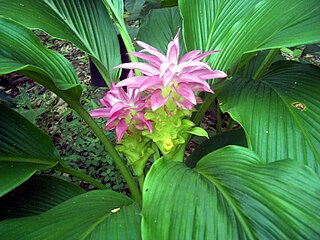
Curcuma australasica, the native turmeric or Cape York lily, is a rhizomatous herbaceous perennial plant of the Zingiberaceae or ginger family.

Curcuma petiolata is a plant of the Zingiberaceae or ginger family.
Curcuma zanthorrhiza, known as temulawak, Java ginger, Javanese ginger, or Javanese turmeric is a plant species, belonging to the ginger family. It is known in Javanese as temulawak, in Sundanese as koneng gede and in Madurese as temu labak. The scientific name is sometimes written as Curcuma xanthorrhiza, but this is an orthographical variant.

Chamaecostus cuspidatus, common name fiery costus or spiral flag, is a species of herbaceous plant in the family Costaceae native to eastern Brazil. In India, it is known as insulin plant for its purported anti-diabetic properties.
Hitchenia is a genus of plants in the ginger family. It contains only one recognized species, Hitchenia glauca, endemic to Myanmar (Burma).

Costus curvibracteatus is a tropical rhizomatous perennial native to Costa Rica and Panama. A member of the spiral ginger family of plants, its common name is orange tulip ginger. It is also sometimes referred to as spiral ginger; however, this common name is better associated with Costus barbatus, a more widely cultivated and very similar species. Despite the name and its relation to the ginger family (Zingiberaceae), the rhizomes of the orange tulip ginger are not edible.




















